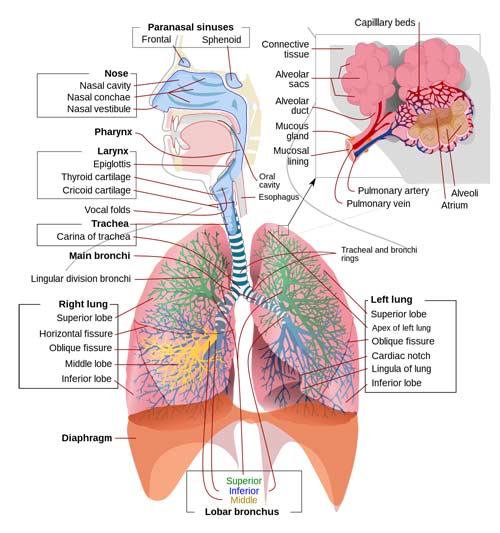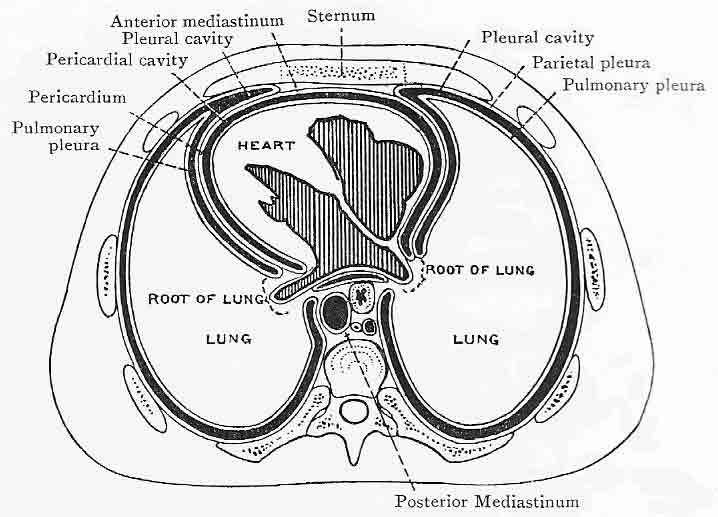respiration

Figure 1. Schematic view of the human respiratory system.

Figure 2. Transverse section of the thorax.
Respiration is a term applied to several activities and processes occurring in all animals and plants: e.g., the breathing movements associated with the lungs, the uptake of oxygen and the release of carbon dioxide, and the metabolic process in which complex organic substances are broken down into simpler products with the release of energy. This energy is incorporated into the energy-carrying substance ATP and subsequently used for other metabolic processes. The metabolic aspect of respiration is carried out within the cells of organisms by the citric acid cycle (Kreb's cycle) and oxidative phosphorylation.
Breathing movements, if any, and the exchange of oxygen and carbon dioxide are called ventilation or external respiration, while the energy-releasing processes which utilize the oxygen and produce carbon dioxide (or the reverse in plants) are called internal respiration or cellular respiration.
In humans, external respiration is the process whereby air is breathed from the environment into the lungs to provide oxygen for internal respiration. Air, which contains about 20% oxygen, is drawn into the lungs via the nose or mouth, the pharynx, trachea, and bronchi. This is achieved by muscle contraction of the intercostal muscles in the chest wall and of the diaphragm; their coordinated movement, controlled by a respiratory center in the brainstem, causes expansion of the chest, and thus of the lung tissue, so that air is drawn in (inspiration). Expiration is usually a passive process of relaxation of the chest wall and diaphragm, allowing the release of the air, which is by now depleted of oxygen and enriched with carbon dioxide. Exchange of gases with the blood circulating in the pulmonary capillaries occurs across the lung alveoli and follows simple diffusion gradients.
Chief organs of respiration
The purpose of the movements of the chest-wall in respiration is to draw air into the lungs and to drive it out again.
The lungs are a pair of organs that occupy the greater part of the interior of the chest. They resemble a sponge – a multitude of small cavities with thin walls – and they are very distensible and very elastic. The cavities within them are in free communication with the exterior through the air-passages, namely: (1) the nose and the mouth; (2) the pharynx or throat; (3) the larynx or voice-box; (4) the trachea or wind-pipe; and (5) a pair of tubes called the bronchi into which the trachea divides.
Each bronchus enters a lung and breaks up into a large number of air-tubes within it. The bronchus enters the lung at the center of its medial surface, and is accompanied by the pulmonary vessels and nerves. Collectively, these structures are called the root of the lung, and they connect the lung with other structures – chiefly the trachea and the heart. The place where they enter is called the hilum of the lung (Figure 1).
To lessen friction during the movements of respiration, there is a serous membrane – a thin membrane whose free surface is smooth and glistening and is moistened with lymph-like serous fluid. This membrane is called the pleura. It is in the form of a sac which has been invaginated from the medial side by the lung during development, so that it comes to have two layers which are continuous with each other around the root of the lung. The inner layer covers and adheres to the lung, and is called the pulmonary pleura; the outer layer is called the parietal pleura because it lines the parietes or walls of the space in which the lung lies. The cavity of the sac, between the two layers of the pleura, is a mere capillary interval occupied by the film of serous fluid that keeps their smooth surfaces moist and enables them to glide (Figure 2).
Disorders of respiration
These include lung disease (e.g., emphysema, pneumonia, and pneumoconiosis); muscle and nerve disease (e.g., brainstem stroke, poliomyelitis, myasthenia gravis, and muscular dystrophy; skeletal deformity; asphyxia, and disorders secondary to metabolic and heart disease. See also respiratory distress syndrome and respiratory failure.


